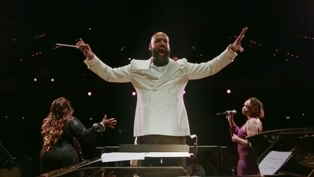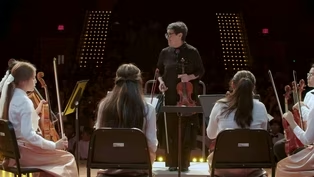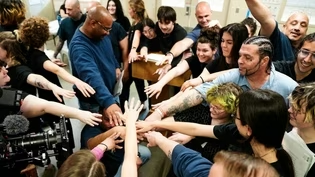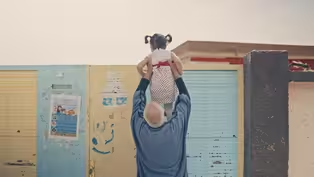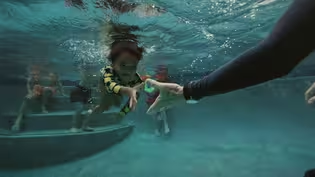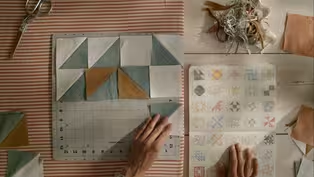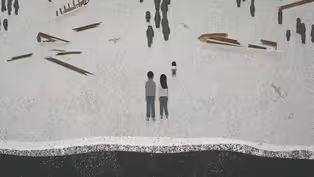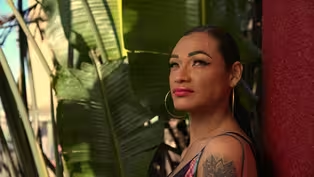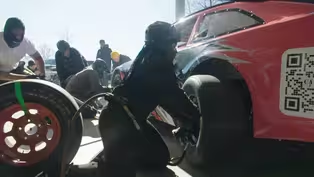
POV Shorts: Take the A Train
Season 35 Episode 503 | 24m 30sVideo has Audio Description, Closed Captions
Two stories from the heart of New York.
Two stories from the heart of New York. A portrait of the life and work of Jamaican New Yorker and visual artist Michael Richards. A close look at disabled New Yorkers fighting for accessibility on the MTA.
See all videos with Audio DescriptionADProblems playing video? | Closed Captioning Feedback
Problems playing video? | Closed Captioning Feedback
Major funding for POV is provided by PBS, The John D. and Catherine T. MacArthur Foundation, the Wyncote Foundation, Reva & David Logan Foundation, the Open Society Foundations and the...

POV Shorts: Take the A Train
Season 35 Episode 503 | 24m 30sVideo has Audio Description, Closed Captions
Two stories from the heart of New York. A portrait of the life and work of Jamaican New Yorker and visual artist Michael Richards. A close look at disabled New Yorkers fighting for accessibility on the MTA.
See all videos with Audio DescriptionADProblems playing video? | Closed Captioning Feedback
How to Watch POV
POV is available to stream on pbs.org and the free PBS App, available on iPhone, Apple TV, Android TV, Android smartphones, Amazon Fire TV, Amazon Fire Tablet, Roku, Samsung Smart TV, and Vizio.
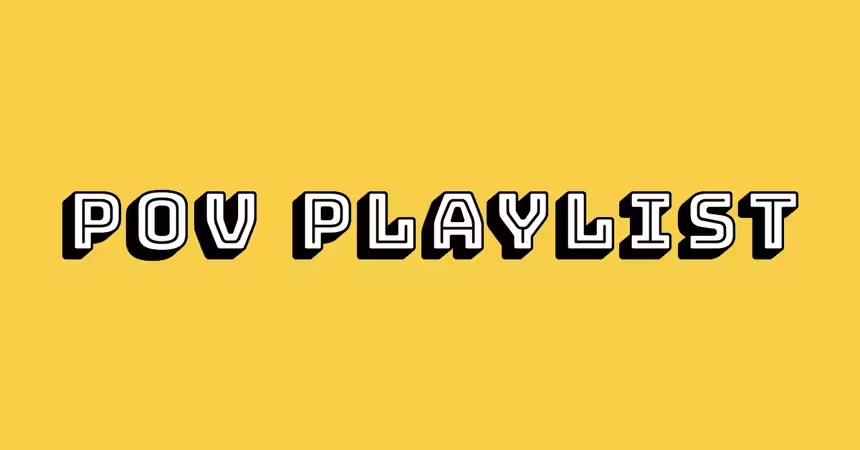
POV Playlist
Every two weeks, we curate a selection of POV docs, old and new, around a central theme. Stream while you can — until the next Playlist!Providing Support for PBS.org
Learn Moreabout PBS online sponsorshipMore from This Collection
The best and boldest independent short films, curated by America's longest-running documentary
POV Shorts: Songs of Black Folk
Video has Closed Captions
Leading Black musicians in the Pacific Northwest create new traditions on Juneteenth. (26m 55s)
Video has Closed Captions
A retired music teacher starts Georgia’s first youth orchestra for immigrant families. (22m 5s)
Video has Closed Captions
A history professor teaches a class of free and incarcerated students inside a prison. (38m 2s)
Video has Closed Captions
From big city to small town, two stories reflecting contemporary America. (25m 5s)
POV Shorts: The People Could Fly
Video has Closed Captions
A poetic look at roller rinks as sanctuaries for Black culture, joy, and resistance. (21m 48s)
Video has Closed Captions
Photographer James Balog brings the 15-year Extreme Ice Survey project to a close. (25m 5s)
Video has Audio Description, Closed Captions
Ahmed must find a way to get his son’s remains back home to Morocco so he can say goodbye. (40m 19s)
Video has Audio Description, Closed Captions
Kids learn to swim - and, in their lessons, we discover profound wisdom for all. (21m 9s)
Video has Audio Description, Closed Captions
Two stories of quilted heirlooms and generational nostalgia. (24m 35s)
Video has Audio Description, Closed Captions
Families traverse tradition and memory in marking new phases of life. (25m 5s)
Video has Audio Description, Closed Captions
A portrait of the experiences unique to displaced queer people fleeing violence at home. (25m 5s)
Video has Audio Description, Closed Captions
Two stories of women who trailblaze and persist. (24m 50s)
Providing Support for PBS.org
Learn Moreabout PBS online sponsorship♪♪ ♪♪ [ Object sliding ] -[ Man speaking indistinctly ] Down.
[ Indistinct conversations ] [ Thud ] ♪♪ -I first met Michael in November of 1997.
Louis was showing me the ArtCenter, and Michael came out of his studio and joined us, and he was very gracious.
And that's where our rich conversations really took off.
♪♪ -My first impression of Michael was this very tall, gentle giant.
I don't know if he knew it, but he kind of, like, seduces you when he talks to you.
-He was smart.
He was funny.
And he was a great teacher to me.
-I had just gotten out of art school and I'm trying to de-learn everything that I've been indoctrinated with.
And here's Michael.
-I wouldn't be here without my art family, if you will, and he was art family.
[ Indistinct conversations ] ♪♪ -He moved fluidly between spaces, social spaces, you know, artistic spaces.
The studio, the street, the museum, the gallery.
-This is family.
-This is family.
Okay.
-[ Speaks indistinctly ] -Had so many different friendships.
♪♪ -He made people laugh.
Michael was just good people.
So you were happy to be around him.
[ Laughter ] ♪♪ -A lot of my work deals with issues of immigration, assimilation, Black culture, um... and attraction/repulsion to sort of the larger society.
And I use -- I've been traveling since I was a child.
I grew up in Jamaica, in the West Indies.
And planes have always been a big part of my life.
Pilots, in my work, function as a symbol of, um -- They're almost images of transcendence.
They're these beings that go up into the sky, you know, just the offer a freedom of escape, of, you know, coming to a new land, of you know, the Yellow Brick Road and success and all of that.
But you always come back down to the ground, you know?
It's always, you know, maybe -- I'm Catholic, so maybe it's a little too religious, but it's, you know, always this descent, you know, from the high points back down to the ground and always a struggle of trying to transcend, to be high again.
♪♪ -There is almost no material in Michael Richards' work that I can think of that doesn't have the multiple meanings and references.
♪♪ ♪♪ Each material that he uses -- There's tar.
There's barbed wire.
Feathers.
Mirrors.
Each of them has both a really charged meaning, sometimes referring to racist stereotypes... ♪♪ ...or also a poetic kind of meaning in society, a mirror reflecting you back while you're looking at the work.
[ Indistinct conversations ] ♪♪ -One aspect of the work that really means a lot is the fact that Michael casts most of his sculptures from his own body.
-He talked about double consciousness and what does it mean to be Black and American and have these warring ideals in one Black body.
And Caribbean adds a different layer, so it's like -- I'm a fine artist, I'm trained in the Western art tradition.
But I don't have the same assumptions about America or the West that many people who are celebrated artists do, and so that work is gonna be different.
[ Fans whirring ] ♪♪ -We have envisioned this exhibition in four primary components.
So, we have the sculptures, obviously.
Sculpture was the biggest body of work that Michael Richards created.
Then we have the drawings which are behind you, if you turn around, on this wall over here.
And then we have these installation images which represent works that we couldn't represent physically in the exhibition.
And then we also have over here an area with a vitrine and remembrances to represent Michael Richards during his life and through friends, colleagues, and peers who remember him through their words.
♪♪ -He did the series of drawings.
"Escape Plan," 1 to 12.
And he had text for each of the drawings.
♪♪ ♪♪ -Largely it was a philosophical thing of trying to get to a world where you aren't constrained and confined by the racism that defines this world and, because you are Black, actually can literally kill you.
♪♪ -Yesterday, I fulfilled one of my ambitions as a combat pilot.
I got one airplane.
-An American far from home, fighting a war around the world.
Listen again.
-This was my leader.
And the second ship was me.
And two...came on my right.
I turned right and put up a stone wall of bullets.
-A wall of bullets.
It wasn't so long ago these men were students in a university, workmen in a shipyard.
♪♪ [ Indistinct conversations ] ♪♪ -The first revelatory moment was seeing Tar Baby vs. St. Sebastian.
Standing there -- Like, I get chills right now.
[ Laughs ] ♪♪ -You know, he's dressed up as a Tuskegee Airmen, and there are these planes flying in and out.
I mean, that one is haunting.
♪♪ -When Michael told me that he got a studio and he was moving back to New York City, and then he told me it's going to be at the Twin Towers, I -- It was very odd for me.
A studio in an office building.
How will that work?
The first thing that came into my head was like, "How is he gonna keep it clean?"
He says, "Yeah, but it's free.
They're offering it to me."
I'm like, "Alright."
-My studio was in Williamsburg on Berry and North 8th.
and had a clear view out of my back window of the skyline, and I could see the Towers.
-We drove to New York to drop off works.
We stayed there for about a week.
♪♪ -He was working on a second version of Tar Baby.
He was so excited about the new work.
-Got to Miami on the 11th.
In the morning.
I think around 5:00 in the morning.
-Phone wakes me up, and it's my mother in Miami screaming, like, "Did you see it?"
And I was like, "What are you talking about?"
I look out the back window, and I see the first -- Tower 1 on fire, and then I see the second plane coming in, like, in slow motion, and it hits.
[ People screaming ] ♪♪ -Oh... [ Sirens wailing ] ♪♪ -I thought to myself, "No.
It's alright.
It's late.
Michael must have left."
He had to be at the Studio Museum at 9:00 in the morning.
[ Radio chatter ] [ Indistinct conversations ] ♪♪ -Apparently Michael had spent the night there.
He had really gotten so excited working in his studio that he had decided to spend the night because it got late and he was tired.
And we didn't know this initially, but slowly his friends who were -- shared studio space with him sort of filled in a lot of those missing gaps.
[ Sirens wailing ] ♪♪ It was such a strange time.
♪♪ -Where's Michael?
A couple of days later, we realized that no one had seen him or talked to him.
[ Radio chatter, sirens wailing ] -We're moving some people.
Be advised.
We're moving some people... -There he is.
Superstar.
-Michael Richards.
[ Indistinct conversations ] -How you doing?
-How are you?
-Alright.
Hi.
[ Indistinct conversations ] -Michael's legacy -- or Michael's entry point, I think, to me, is, like, that first generation of artists that were raised in hip-hop, not giving a... of what was going on, whether it was being accepted by the galleries or the curators.
They were just pushing forward and making this work.
Where would all these artists be now had it not been for that group of artists that did that kind of work?
-The artwork is brilliant.
Our younger generation of artists is now thinking about Blackness, Black bodies, escape, oppression, colonialism.
Those are all things that Michael was exploring, you know, 25 years ago, and so I'm glad that he's being written into art history.
His work should be included and celebrated and known about.
[ Drills whirring ] -People talk about the art and the importance of the art, but just as often people talk about him as a friend.
-The one thing that I miss most about Michael is Michael.
-Let's do a tour.
-Okay.
-Okay.
-And here we have the best piece in the show.
[ Laughter ] -Come on.
[ Laughter ] Okay.
Let's talk about this piece here.
-This is the ass of the... [ Laughter ] -I was looking at it and I said, "That's not Michael's butt.
[ Laughter ] That isn't Michael's butt."
I said, "Who is it?"
♪♪ ♪♪ ♪♪ ♪♪ [ Train rumbling ] ♪♪ -My mom calls me the "luckiest unlucky guy", which I think is about as succinctly as you can put it.
On July 29, 2009, when I was doing my usual walk to work; get a little exercise, get some air, and just think about the day ahead.
A giant rotten limb fell from a tree as I walked beneath it in Central Park, and clobbered me.
What they found was it probably hit me more or less on the head.
And the reason I'm still here is amazing good luck after that moment.
It's hard to think of it as good luck, but there was a doctor, Rajiv Narula, who was jogging by.
He said, "You've obviously had an arterial bleed because the blood was coming out dun-dun, dun-dun, dun-dun.
And that's kind of it.
If you -- If nobody finds you, you bleed out.
That's sort of it.
So what does it mean to get around when you can't walk?
-Thank God there's no urine!
It smells not so bad over here.
As elevators go, it's pretty good.
Pretty good, this one.
Thanks.
You have to be very patient, very patient when you do this.
It's not good.
It's not good.
-Hello?
-This is one of the big stations in the city!
34th Street, Herald Square!
Jail!
This is jail!
This is jail!
Jail!
[ Chuckles ] -You can probably get in.
-Go ahead.
So, my cousin Rosie, intrepid young reporter.
"So, you were telling me about those elevators in the subway not working, so I got my guy I work with to put in a FOIL, Freedom of Information Law request to the MTA.
They sent him back a year's worth of the elevator outages from 2014 to 15, one year."
I looked at it and said, "Oh [bleep] this is bad."
Because there were 9,000 outages.
9,000 elevator breakdowns over the course of a year.
And, like, that's a number that is hard to comprehend.
Right?
So I started crunching the numbers.
I had them in a big spreadsheet.
And I said, "What is that?
9,000?"
Over the course of a year, 365 days in a year.
That's 25 per day.
Wait, there's like more or less 100 stations that are even accessible in the first place.
So if 25 go out a day, that means like a quarter of the stations, at some point during the day, had an elevator that wasn't working.
What?
What?
It's not, like, understood that when an elevator is out at a station, that station is off limits, it is closed for anyone in a wheelchair.
But who else?
It's parents with little kids.
Pregnant women.
Old people, but also young people.
And any people who break their ankle and have a cane.
It's delivery workers pushing a case of soda on a hand truck.
It's our economy.
-I think the entire management of MTA has been pretty bad historically.
They've always treated The Bronx, and even more particular, areas near the South Bronx as almost secondary customers for the MTA.
-How you doing?
-The MTA doesn't really care.
We tend to get the bottom of the barrel.
-All right, so here we are at the Parkchester train station.
We're in front of the station right here.
If you can see that in front of the station, all this space here should have been utilized when they did the reconstruction a couple of years ago.
This is the area where the elevator should be.
There's a plaque here.
"MTA New York City Transit Authority.
Parkchester Station.
Rehabilitated in 2012."
I don't know what that means.
Rehabilitated doesn't mean ADA compliance.
-What they do is they try to engage in legal jargon to figure out how they can avoid to comply with certain federal laws or state laws.
They're very adept at it, they've been doing it for years.
We know that it's mismanagement!
However, we haven't been able to establish it, per se, because they guard their books like if it was a state secret.
-Hey, hey, MTA!
We're not going to go away!
Hey, hey, MTA!
We're not going to go away.
-Governor Cuomo or Governor Cardboard, was nice enough to join us today.
And it's his show.
But it's not really so funny because Malaysia Goodson fell down the stairs and died with her stroller.
It's just not right.
-What do we want?
-Elevators!
-When do we want them?
-Now!
-What do we want?
-Elevators!
-When do we want them?
-Now!
-Malaysia was an excellent mother.
She was always an ear for everybody to talk to.
-She was definitely more mature than all of us.
-I was home when I heard the news that Malaysia died.
My whole world was upside down.
Everything just stopped.
The pain that I'm going through now is a pain I didn't even think exists.
Just imagining... ...as she was going down, what was going through her mind.
It's really a lot to take in.
This is where my baby took her last breath in.
-I feel so funny just being here.
-Look at this.
Look.
Look at this.
-They need an elevator her for the same reason.
-It's going to be 10 months to the day on Thanksgiving, Malaysia's been gone.
Last year, I would have never imagined that my baby wouldn't be here with us this Thanksgiving.
Her birthday is coming up.
[ Sobs ] Oh, God.
-It's terrible and sad, but... ...people die in accidents every day, but this is one that didn't have to happen like that.
-Leadership matters.
New York City Transit now has a new focus on accessibility thanks to hiring people like Alex Elegudin.
-My name is Alex Elegudin.
I'm the Senior Advisor for System Wide Accessibility here at MTA New York City Transit.
I oversee accessibility for subways, buses, and our paratransit division on behalf of the president.
I mean, having somebody with a disability working with those who are the decision-makers is the most collaborative and beneficial way to get change made.
Here.
I'm empowering you.
Lead us on the push toward full accessibility.
I think that's how you get it done.
There are so many different disabilities.
Those disabilities interact with our transit system in so many different ways.
So by playing this role internally, I feel like I'm building the bridge, right?
I'd like to believe I represent the bridge from the community and the advocates to the executive and leadership here at New York City Transit.
We feel incredibly fortunate, a historic investment into 70 ADA stations.
This is a tripling of the pace that we have usually done in 5-year terms.
It really puts into perspective and hope that full accessibility may one day be a possibility.
-"MTA riding first class."
How come I don't feel like first class?
-It's a plan.
It's another plan.
And the track record is not good.
I'll hold my applause for now.
-You know, the only thing I can say is just give us a chance to deliver.
But just saying that it's all talk I think is -- it's just them being just critics.
And just, you know...
...I would say maybe even going to a level where they're not supporting the cause itself by not letting us get on with our work.
[ Crowd chanting ] -Government doesn't want to be held accountable and doesn't want to be pushed.
They want to be left alone to let them do their own thing when they're getting it done.
-Yes.
Oh, yes.
Yes.
Yes.
-Accountability, efficiency, and transparency are not adjectives that anyone would use to describe the MTA.
-There is always a lot of factors.
People want to say, "Look, it should just be accessible.
It's cut and dry, make it accessible."
But it's never that simple.
-...not disposable!
-Disabled not disposable!
-Disabled not disposable!
-Somebody has to get killed so we can do something?
We're on a collision course.
-Recognizing that accessibility and inclusion is in all of our best interests takes vision.
-People with disabilities have a right to have the accessible New York that able-bodied people have.
And they just don't.
-When you're talking about securing people's rights, many times, the last line of defense are the courts.
-We need something like a legal binding agreement.
-What do we want?
-Elevators!
-And when do we want them?
-Now!
♪♪ ♪♪ ♪♪
Support for PBS provided by:
Major funding for POV is provided by PBS, The John D. and Catherine T. MacArthur Foundation, the Wyncote Foundation, Reva & David Logan Foundation, the Open Society Foundations and the...
